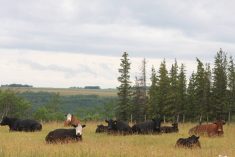Prime Minister Trudeau’s five-day visit to China last month had a sense of déjà vu about it for cattle producers.
The PM was there to keep alive the hope of a free trade agreement with the second-largest economy in the world, but came away with little more than his promise that Canada would continue to discuss an FTA with China. As he told Reuters, “It’s an opportunity that makes sense for Canadian business.”
“Canada is and always has been a trading nation. But the landscape of trade is shifting and we need to adjust to it.”
Read Also

What to know before you go to Agribition 2025
If you’re attending Agribition 2025, this is the place to find out about tickets, dates and what’s happening this year.
While sharing the spotlight with Premier Li Keqiang, Trudeau said he was pleased to announce Canadian beef and pork will have greater access to the Chinese market.
It was somewhat reminiscent of the decision by China to lift its 13-year ban on U.S. beef after a two-day meeting between President Trump and China’s President Xi Jinping.
In Canada’s case negotiations have been going on since 2016 to add frozen bone-in beef to the frozen boneless beef that has been the only Canadian product China would take up until now.
As a bonus they agreed to a pilot project for the export of Canadian chilled/fresh beef and pork to China from approved Canadian plants.
Both moves were welcome news to the beef and pork sectors. The only thing that wasn’t clear was when China will open its doors wider to Canadian product.
This will be a big deal when we gain access to fresh and bone-in markets.
In 2016 we sold $61 million worth of frozen boneless beef to China and $161 million to Hong Kong. To December 2 of this year, sales were down a bit in Hong Kong and up a bit in China.
Access explains some of the difference in these two markets. Hong Kong imports boneless and bone-in beef including offal from animals of all ages with no production restrictions.
China up to now has taken only frozen boneless beef from cattle under 30 months, bred and fed in Canada, certified free of Beta Agonists and with a raft of requirements designed to segregate the meat until it lands in China.
The Canadian Food Inspection Agency has posted a similar protocol for bone-in beef to China, but we were unable to confirm this was the final version.
As a first step, plants currently cleared to ship boneless beef will need to be certified to handle the bone-in product.
Adding frozen bone-in cuts would increase the potential value of this market considerably, and chilled/fresh cuts would put us into the premium end of the market now dominated by our competitors. When Canadian Cattlemen’s Association (CCA) vice-president David Haywood-Farmer joined Agriculture Minister Lawrence MacAulay’s trade mission to China in November he saw a single 12-ounce Australian ribeye selling for the equivalent of $130 CDN.
This is not the bulk of the business in China, however. Australian Meat and Livestock 2016 sales to China broke down to $656 million (AU) in frozen beef and $80.9 chilled fresh beef.
By volume Australia sold a little over 94,000 tonnes to China in 2016; brisket accounted for 23 per cent, shin/shank 14 per cent, manufacturing beef 14 per cent, blade seven per cent and rest a collection of other products. Much of it was grass-fed beef, as well.
Offal added another 4,400 tonnes, but we are still banned from selling offal to China.
To the end of October we sold China 6,100 tonnes of frozen boneless. Mind you that’s 55 per cent more than we sold them last year by this time. But it’s fair to say we’ve got a long way to go in a very competitive market dominated by Australia, Brazil, Uruguay and now the U.S.
Canada is never going to be a big player in China but it can certainly be a lucrative market for us. One industry estimate says it may be a $175-million-a-year market for Canada within the next five years, assuming we’ve gained regular access to the chilled/fresh trade.
It won’t be easy getting there. Your biggest competitor will be the Chinese themselves. China has 100 million cattle putting it on a par with the U.S. in terms of numbers. Local beef production has been trending up for a few years now while imports levelled off about five years ago, and currently supply about one-fourth of China’s needs. But demand for beef is growing apace with the growing wealth in the country, and Ontario market analyst Kevin Grier says imports are expected to rise until 2022. That’s about the time a new class of professional large-scale farmers are expected to take over the domestic industry.
The Canadian Cattlemen’s Association says its goals for China are to obtain access for offal, gain full approval of our federal meat inspection system and press Ottawa to negotiate a free trade agreement to eliminate the current 12 per cent duty on Canadian beef.
That last one might be tricky given Mr. Trudeau’s current passion for mixing social and trade policies in international negotiations.
















